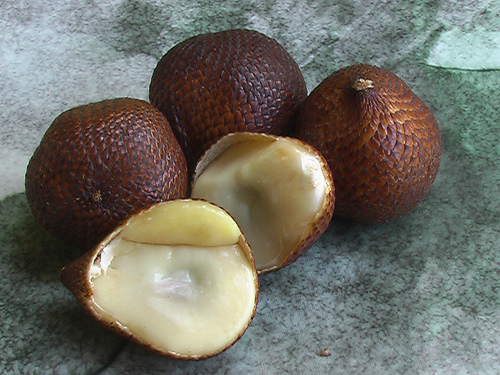The salak will surely snake its way into your fruit basket.
- Salaks are a species of exotic fruit with over 30 varieties, and is native to Indonesia in Southeast Asia.
- ‘Salak’ is also known as ‘sala’, ‘snake fruit’, ‘yingan’, ‘salacca fruit’, and ‘snakeskin fruit’; and it grows on a specific type of palm tree.
- The scientific name of the plant salaks grow on is Salacca zalacca and it is from the family Arecaceae, the family of palm trees.
- Salaks are of a fig-like shape and are roughly 5 to 7 centimetres (2 to 2.7 inches) in length, and the fruit usually contains one to three seeds.
- Salaks are a mixture of sweet, sour and acidic flavours, comparable to pineapples and apples, and is often quite juicy.
Salak
Image courtesy of Jayson Emery/Flickr
- The skin of salaks is a brown colour resembling snake skin, hence its alternate names; and the skin can have small spines.
- Salak flesh is typically divided in three segments and is cream coloured with a texture that can be firm, spongy or crispy, or sometimes dry and crumbly.
- Salaks typically bunch on the palm tree, towards the base of the trunk, in groups of ten to forty individual fruits.
- It is traditional for salaks to be eaten fresh just as they are, or in fruit salad, but they can also be pickled, sugared, canned or made into wine.
- Salaks are high in iron and are a good source of vitamin C, and they contain many other vitamins and minerals.
Bibliography:
Bali Salak, n.d, Fruitipedia, http://www.fruitipedia.com/bali_salak%20Salaca%20edulis.htm
Nuwer R, Meet the Salak, the Ubiquitous Indonesian Fruit You’ve Never Head Of, 2012, Smithsonian, http://www.smithsonianmag.com/arts-culture/meet-the-salak-the-ubiquitous-indonesian-fruit-youve-never-heard-of-115942678/?no-ist
Salak, 2016, Wikipedia, https://en.wikipedia.org/wiki/Salak
Salak – An Exotic Indonesian Fruit, n.d, Blue Karma Resort, http://bluekarmaresort.com/salak-an-exotic-indonesian-fruit/







